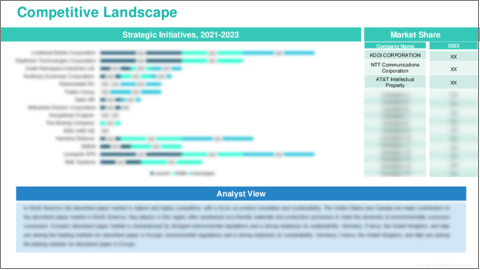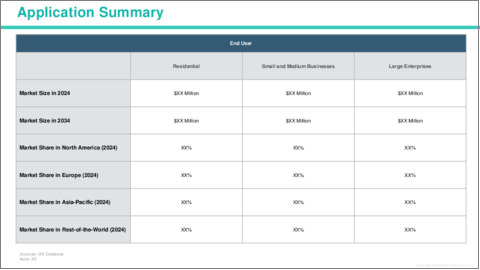|
|
市場調査レポート
商品コード
1485692
IPv6の世界市場:製品タイプ別、エンドユーザー別、地域別:分析と予測(2024年~2034年)Global IPv6 Market: Focus on Product Type, End User, and Region - Analysis and Forecast, 2024-2034 |
||||||
カスタマイズ可能
|
|||||||
| IPv6の世界市場:製品タイプ別、エンドユーザー別、地域別:分析と予測(2024年~2034年) |
|
出版日: 2024年05月29日
発行: BIS Research
ページ情報: 英文 100 Pages
納期: 1~5営業日
|
- 全表示
- 概要
- 目次
IPv6市場は、デジタルランドスケープにおけるその軌道を形成するいくつかの重要な要因によって牽引されています。
楽観的シナリオを考慮すると、2024年の市場規模は71億1,000万米ドルになるとみられ、今後は、18.96%のCAGRで拡大し、2034年には403億9,000万米ドルに達すると予測されます。
| 主要市場統計 | |
|---|---|
| 予測期間 | 2024年~2034年 |
| 2024年評価 | 71億1,000万米ドル |
| 2034年予測 | 403億9,000万米ドル |
| CAGR | 18.96% |
IPv4アドレスの枯渇がIPv6導入を急速に促進し、世界中の企業や組織が次世代インターネットプロトコルへの移行を促しています。この移行は、モノのインターネット(IoT)デバイスの急成長によってさらに加速しており、これらのデバイスは、業界全体への普及をサポートするためにIPv6が提供する広範なアドレス空間と強化されたセキュリティ機能を必要としています。しかし、IPv6の導入に課題がないわけではありません。レガシーインフラの互換性の問題は、IPv6への移行を目指す組織にとって大きなハードルとなり、シームレスな統合を確実にするためにハードウェア、ソフトウェア、トレーニングへの投資が必要となります。さらに、企業、消費者、IT専門家がIPv6導入への抵抗を克服するためには、包括的な理解とサポートが必要であるため、IPv6を取り巻く認識と教育の不足に対処することは、依然として重要な課題となっています。
このような課題にもかかわらず、IPv6の採用は、IoTやスマートシティなどの新興市場やサービスを展開し、IPv6のスケーラビリティ、セキュリティ、相互運用性を活用してイノベーションを推進し、相互接続が進むデジタルエコシステムにおいてサイバーセキュリティの防御を強化し、機密データを保護しながら、進化する顧客の需要に応えるという、企業にとって有益な機会をもたらします。
当レポートでは、世界のIPv6市場について調査し、市場の概要とともに、製品タイプ別、エンドユーザー別、地域別の動向、および市場に参入する企業のプロファイルなどを提供しています。
目次
エグゼクティブサマリー
第1章 市場:業界の見通し
- 動向:現在および将来の影響評価
- サプライチェーンの概要
- 規制状況
- ステークホルダー分析
- 主要な世界的イベントの影響分析
- 市場力学の概要
- 市場促進要因
- 市場抑制要因
- 市場機会
第2章 IPv6市場、用途別
- 用途のセグメンテーション
- 用途の概要
- IPv6市場、エンドユーザー別
- 住宅
- 中小企業
- 大企業
第3章 IPv6市場、製品別
- 製品セグメンテーション
- 製品概要
- IPv6市場、製品タイプ別
- DS-L1000
- FTTHサービス
第4章 IPv6市場、地域別
- IPv6市場- 地域別
- 北米
- 欧州
- アジア太平洋
- その他の地域
第5章 企業プロファイル
- 今後の見通し
- 地理的評価
- NTT Communications Corporation
- KDDI CORPORATION
- SoftBank Corp.
- Equifax Inc.
- Verizon
- AT&T Intellectual Property
- China Telecom Global Limited
- ALE International
- Apple Inc.
- Cisco Systems Inc.
- D-Link Corporation
- Hewlett Packard Enterprise Development LP
- Hitachi, Ltd.
- IBM
- MatrixStream Technologies, Inc.
- その他
第6章 調査手法
Introduction to the IPv6 Market
The IPv6 Market is driven by several key factors shaping its trajectory in the digital landscape. Considering the optimistic scenario, the market is valued at $7.11 billion in 2024 and is expected to grow at a CAGR of 18.96% to reach $40.39 billion by 2034.
| KEY MARKET STATISTICS | |
|---|---|
| Forecast Period | 2024 - 2034 |
| 2024 Evaluation | $7.11 Billion |
| 2034 Forecast | $40.39 Billion |
| CAGR | 18.96% |
The exhaustion of IPv4 addresses has spurred the urgent need for IPv6 adoption, prompting businesses and organizations worldwide to transition to the next-generation internet protocol. This shift is further accelerated by the rapid growth of the Internet of Things (IoT) devices, which require the extensive address space and enhanced security features offered by IPv6 to support their proliferation across industries. However, IPv6 adoption is not without its challenges. Legacy infrastructure compatibility issues pose significant hurdles for organizations seeking to migrate to IPv6, necessitating investments in hardware, software, and training to ensure seamless integration. Additionally, addressing the lack of awareness and education surrounding IPv6 remains a crucial task, as businesses, consumers, and IT professionals require comprehensive understanding and support to overcome resistance to IPv6 adoption.
Despite these challenges, IPv6 adoption presents lucrative opportunities for businesses to tap into emerging markets and services, such as IoT and smart cities, leveraging IPv6's scalability, security, and interoperability to drive innovation and meet evolving customer demands while enhancing cybersecurity defenses and protecting sensitive data in an increasingly interconnected digital ecosystem.
North America shows strong IPv6 adoption, indicative of significant regional investments in network infrastructure and technology. Specific adoption rates in North America can be interpreted as high. For instance, as per BIS Research Analysis, the U.S. has a figure of around 70% adoption of the web among the top domains.
As the Internet of Things (IoT) landscape undergoes an unprecedented expansion, IPv6 emerges as a critical enabler, addressing the scalability challenge posed by the limited IP address space of its predecessor, IPv4.
IPv6 offers a formidable solution with its expansive address space of 2^128 possible addresses, compared to the 4.3 billion provided by IPv4. As per BIS Research Analysis, it is expected that the number of IoT devices surpass 75 billion worldwide by 2025. The transition to IPv6 has been uneven globally, with adoption rates as high as 47% in countries such as Belgium, reflecting advanced IoT infrastructure integration, while other regions are still emerging from the nascent stages of IPv6 deployment. This variation presents a global patchwork of adoption, correlating closely with IoT growth rates and regional technological infrastructure development.
Market Segmentation:
Segmentation 1: by End User
- Residential
- Small and Medium Businesses
- Large Enterprises
Segmentation 2: by Product Type
- DSL
- FTTH Services
Segmentation 3: by Region
- North America
- Europe
- Asia-Pacific
- Rest-of-the-World
Key Market Players and Competition Synopsis
The companies that are profiled in the global IPv6 market have been selected based on input gathered from primary experts and analyzing company coverage, product portfolio, and market penetration.
Some of the prominent companies in this market are:
- Cisco Systems Inc.
- D-Link Corporation
- Hewlett Packard Enterprise Development LP
- Verizon
Key Questions Answered in this Report:
- What are the main factors driving the demand for IPv6 adoption in the global market?
- Who are the predominant competitors in the IPv6 marketplace, and how do their market shares compare?
- What are the key partnerships or alliances that are shaping the IPv6 industry landscape?
- Which strategies are leading organizations implementing to secure a competitive edge in the IPv6 arena?
- How does the future of the IPv6 market look in terms of growth and development potential?
- What is the current valuation of the IPv6 market, and what is its expected growth path from 2024 to 2034?
- During the forecast period from 2024 to 2034, which product and application segments are predicted to dominate the IPv6 market?
- How might the escalating demand from end-users impact the global IPv6 market dynamics?
- In which geographical regions are IPv6 solutions being adopted most rapidly, and what are the driving forces behind their dominance?
Table of Contents
Executive Summary
Scope and Definition
Market/Product Definition
Key Questions Answered
Analysis and Forecast Note
1. Markets: Industry Outlook
- 1.1 Trends: Current and Future Impact Assessment
- 1.2 Supply Chain Overview
- 1.2.1 Value Chain Analysis
- 1.2.2 Pricing Forecast
- 1.3 Regulatory Landscape
- 1.4 Stakeholder Analysis
- 1.4.1 Use Case
- 1.4.2 End User and Buying Criteria
- 1.5 Impact Analysis for Key Global Events
- 1.6 Market Dynamics Overview
- 1.6.1 Market Drivers
- 1.6.2 Market Restraints
- 1.6.3 Market Opportunities
2. IPv6 Market by Application
- 2.1 Application Segmentation
- 2.2 Application Summary
- 2.3 IPv6 Market by End User
- 2.3.1 Residential
- 2.3.2 Small and Medium Businesses
- 2.3.3 Large Enterprises
3. IPv6 Market by Products
- 3.1 Product Segmentation
- 3.2 Product Summary
- 3.3 IPv6 Market by Product Type
- 3.3.1 DSL
- 3.3.2 FTTH Services
4. Global IPv6 Market by Region
- 4.1 IPv6 Market - by Region
- 4.2 North America
- 4.2.1 Regional Overview
- 4.2.2 Driving Factors for Market Growth
- 4.2.3 Factors Challenging the Market
- 4.2.4 Application
- 4.2.5 Product
- 4.2.6 U.S.
- 4.2.6.1 Market by Application
- 4.2.6.2 Market by Product
- 4.2.7 Canada
- 4.2.7.1 Market by Application
- 4.2.7.2 Market by Product
- 4.2.8 Mexico
- 4.2.8.1 Market by Application
- 4.2.8.2 Market by Product
- 4.3 Europe
- 4.3.1 Regional Overview
- 4.3.2 Driving Factors for Market Growth
- 4.3.3 Factors Challenging the Market
- 4.3.4 Application
- 4.3.5 Product
- 4.3.6 Germany
- 4.3.6.1 Market by Application
- 4.3.6.2 Market by Product
- 4.3.7 France
- 4.3.7.1 Market by Application
- 4.3.7.2 Market by Product
- 4.3.8 U.K.
- 4.3.8.1 Market by Application
- 4.3.8.2 Market by Product
- 4.3.9 Italy
- 4.3.9.1 Market by Application
- 4.3.9.2 Market by Product
- 4.3.10 Rest-of-Europe
- 4.3.10.1 Market by Application
- 4.3.10.2 Market by Product
- 4.4 Asia-Pacific
- 4.4.1 Regional Overview
- 4.4.2 Driving Factors for Market Growth
- 4.4.3 Factors Challenging the Market
- 4.4.4 Application
- 4.4.5 Product
- 4.4.6 China
- 4.4.6.1 Market by Application
- 4.4.6.2 Market by Product
- 4.4.7 Japan
- 4.4.7.1 Market by Application
- 4.4.7.2 Market by Product
- 4.4.8 India
- 4.4.8.1 Market by Application
- 4.4.8.2 Market by Product
- 4.4.9 South Korea
- 4.4.9.1 Market by Application
- 4.4.9.2 Market by Product
- 4.4.10 Rest-of-Asia-Pacific
- 4.4.10.1 Market by Application
- 4.4.10.2 Market by Product
- 4.5 Rest-of-the-World
- 4.5.1 Regional Overview
- 4.5.2 Driving Factors for Market Growth
- 4.5.3 Factors Challenging the Market
- 4.5.4 Application
- 4.5.5 Product
- 4.5.6 South America
- 4.5.6.1 Market by Application
- 4.5.6.2 Market by Product
- 4.5.7 Middle East and Africa
- 4.5.7.1 Market by Application
- 4.5.7.2 Market by Product
5. Companies Profiled
- 5.1 Next Frontiers
- 5.2 Geographic Assessment
- 5.2.1 NTT Communications Corporation
- 5.2.1.1 Overview
- 5.2.1.2 Top Products/Product Portfolio
- 5.2.1.3 Top Competitors
- 5.2.1.4 Target Customers
- 5.2.1.5 Key Personnel
- 5.2.1.6 Analyst View
- 5.2.1.7 Market Share
- 5.2.2 KDDI CORPORATION
- 5.2.2.1 Overview
- 5.2.2.2 Top Products/Product Portfolio
- 5.2.2.3 Top Competitors
- 5.2.2.4 Target Customers
- 5.2.2.5 Key Personnel
- 5.2.2.6 Analyst View
- 5.2.2.7 Market Share
- 5.2.3 SoftBank Corp.
- 5.2.3.1 Overview
- 5.2.3.2 Top Products/Product Portfolio
- 5.2.3.3 Top Competitors
- 5.2.3.4 Target Customers
- 5.2.3.5 Key Personnel
- 5.2.3.6 Analyst View
- 5.2.3.7 Market Share
- 5.2.4 Equifax Inc.
- 5.2.4.1 Overview
- 5.2.4.2 Top Products/Product Portfolio
- 5.2.4.3 Top Competitors
- 5.2.4.4 Target Customers
- 5.2.4.5 Key Personnel
- 5.2.4.6 Analyst View
- 5.2.4.7 Market Share
- 5.2.5 Verizon
- 5.2.5.1 Overview
- 5.2.5.2 Top Products/Product Portfolio
- 5.2.5.3 Top Competitors
- 5.2.5.4 Target Customers
- 5.2.5.5 Key Personnel
- 5.2.5.6 Analyst View
- 5.2.5.7 Market Share
- 5.2.6 AT&T Intellectual Property
- 5.2.6.1 Overview
- 5.2.6.2 Top Products/Product Portfolio
- 5.2.6.3 Top Competitors
- 5.2.6.4 Target Customers
- 5.2.6.5 Key Personnel
- 5.2.6.6 Analyst View
- 5.2.6.7 Market Share
- 5.2.7 China Telecom Global Limited
- 5.2.7.1 Overview
- 5.2.7.2 Top Products/Product Portfolio
- 5.2.7.3 Top Competitors
- 5.2.7.4 Target Customers
- 5.2.7.5 Key Personnel
- 5.2.7.6 Analyst View
- 5.2.7.7 Market Share
- 5.2.8 ALE International
- 5.2.8.1 Overview
- 5.2.8.2 Top Products/Product Portfolio
- 5.2.8.3 Top Competitors
- 5.2.8.4 Target Customers
- 5.2.8.5 Key Personnel
- 5.2.8.6 Analyst View
- 5.2.8.7 Market Share
- 5.2.9 Apple Inc.
- 5.2.9.1 Overview
- 5.2.9.2 Top Products/Product Portfolio
- 5.2.9.3 Top Competitors
- 5.2.9.4 Target Customers
- 5.2.9.5 Key Personnel
- 5.2.9.6 Analyst View
- 5.2.9.7 Market Share
- 5.2.10 Cisco Systems Inc.
- 5.2.10.1 Overview
- 5.2.10.2 Top Products/Product Portfolio
- 5.2.10.3 Top Competitors
- 5.2.10.4 Target Customers
- 5.2.10.5 Key Personnel
- 5.2.10.6 Analyst View
- 5.2.10.7 Market Share
- 5.2.11 D-Link Corporation
- 5.2.11.1 Overview
- 5.2.11.2 Top Products/Product Portfolio
- 5.2.11.3 Top Competitors
- 5.2.11.4 Target Customers
- 5.2.11.5 Key Personnel
- 5.2.11.6 Analyst View
- 5.2.11.7 Market Share
- 5.2.12 Hewlett Packard Enterprise Development LP
- 5.2.12.1 Overview
- 5.2.12.2 Top Products/Product Portfolio
- 5.2.12.3 Top Competitors
- 5.2.12.4 Target Customers
- 5.2.12.5 Key Personnel
- 5.2.12.6 Analyst View
- 5.2.12.7 Market Share
- 5.2.13 Hitachi, Ltd.
- 5.2.13.1 Overview
- 5.2.13.2 Top Products/Product Portfolio
- 5.2.13.3 Top Competitors
- 5.2.13.4 Target Customers
- 5.2.13.5 Key Personnel
- 5.2.13.6 Analyst View
- 5.2.13.7 Market Share
- 5.2.14 IBM
- 5.2.14.1 Overview
- 5.2.14.2 Top Products/Product Portfolio
- 5.2.14.3 Top Competitors
- 5.2.14.4 Target Customers
- 5.2.14.5 Key Personnel
- 5.2.14.6 Analyst View
- 5.2.14.7 Market Share
- 5.2.15 MatrixStream Technologies, Inc.
- 5.2.15.1 Overview
- 5.2.15.2 Top Products/Product Portfolio
- 5.2.15.3 Top Competitors
- 5.2.15.4 Target Customers
- 5.2.15.5 Key Personnel
- 5.2.15.6 Analyst View
- 5.2.15.7 Market Share
- 5.2.16 Others
- 5.2.1 NTT Communications Corporation






